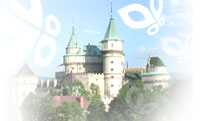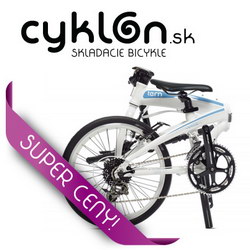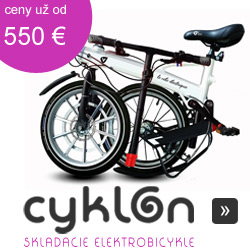

 |
 |
|
| Slovakia´s best facts history UNESCO sights nature sights gastronomy spas swim cyclistics skiing |
VILLAGESVILLAGES IN SLOVAK REGIONS:
B R A T I S L A V A r e g i o nVEĽKE LEVARE
T R N A V A r e g i o nPLAVECKY PETER
BRHLOVCE
The village Brhlovce lies in a basin surrounded by gentle slopes that belong to the southern bottom of the Štiavnické Mountain Range. It is 15 kilometres away eastwards the regional town Levice. The shape of the village neighbourhood was formed by the tertiary volcanic activity. The evidence are the localities here of porous andesitic tuffs and tuffits. In the valley of the village there is a beginning of the stream Búr. The land here was settled already in Stone Age. The first written reference preserved from 1245 and it was recorded under a name of Burfen, later as Horné Brhlovce. In the 16th century arose another yeomanry village in the area, which was documented in 1542 as Boorfeni, later Tegsesborfo and Dolné Brhlovce. The fusion of two autonomous villages Dolné Brhlovce and Horné Brhlovce came in 1952 under the present name Brhlovce. More info: www.brhlovce.sk Z I L I N A r e g i o nCICMANY
More info: www.cicmany.viapvt.sk PODBIEL
Podbiel is typical Orava village. It lies at the point where the Studený stream flows into the Orava river. Located at the centre of the greatest of Orava’s attractions, it is the ideal starting point from which to explore the whole Orava region. Within a range of about 20 km there are the Roháče mountains, the Museum of the Orava village, the Oravice thermal pool, the Oravská priehrada water dam-lake and Orava Castle. At Podbiel, traditional buildings and houses, typical of the central Orava region, which were classified as the Reserve of Folk Architecture, have been preserved in a very good condition. A guided tour through the reserve includes a lecture about the architectural mastery of the builders of the wooden houses. Some of the wooden buildings serve for recreational purposes. An ironworks complex built in 1863, the so-called “hámor” (in the vernacular), whose external walls and central blast furnace have been preserved, is located 2 km from the centre of the village. The TAVBA folk festival regularly takes place in this venue. More info: www.podbiel.sk VLKOLINEC
Vlkolinec is situated on the slope of one of the eastern headlands of
Velka Fatra, in the side valley of the Revuca valley, on the south foot
of the Sidorovo hill, 718 m above sea level. The first written record
about the village is from 1376. The village came into being in the historical
region of the town of Ruzomberok and became its part. At the end of 18th
century the village had 41 houses and 280 inhabitants. The inhabitants
of Vlkolinec were farmers, shepherds, cattle breeders and woodcutters.
The coat of arms of the village was the heraldic rose and coniferous tree
on a mead. In 1944 the village was affected by the war events. A part
of it burnt out (about 20 houses and farm buildings). Up to the present
period about 45 examples of folk architecture have been preserved. The
dominant place of the village, apart from typical wooden houses, is the
wooden belfry from 1770. B A N S K A B Y S T R I C A r e g i o nSPANIA DOLINA
Spania Dolina is only twelve kilometres from Banska Bystrica, and still, visitors feel as they are in a different world. In the world of glamour, in a newly discovered corner of nature. It is situated on the north side of the Low Tatras, 728 m above the sea level. It is surrounded by mountains - Pansky diel, Dolny Sturec, Sachticka, Vlcinec. Wherever you look you can see forests and meadows. The oldest written record of Spania Dolina is from 1263, in which it is mentioned as Montana. Spania Dolina had several historical names. In the late Middle Ages it was called Herrengrund. In the past Spania Dolina was famous all over Europe, it was one of the largest producers of copper with a high content of silver which was mined here since the beginning of the Bronze Age. Copper travelled to Germany, Poland, France, Italy, Spain... Copper mining came to an end by the end of 19th century. Galleries, a huge slag heap above the village, the knocker from 16th century and picturesque miners´ wooden houses from 17th and 18th centuries remind us the mining tradition. Many buildings are even older, namely village and mining buildings and dwellings made of stone and wood. They are more than 500 or 600 years old, some of them have Renaissance flat carved painted ornaments, sometimes covered by later repaint. The old water main also belongs to the valuable monuments. Water was necessary for driving mining machinery. The water main, which astonishes specialists even now, was build from wood. It brought water through covered troughs from below the Prasiva hill, around the Jesenska rock down to the village. The water main was more than 40 km long and it was a unique technological work. As for architectural monuments the most remarkable is the village church
with adjoining buildings - the parsonage, the belfry, the chapel and
the bastion. All this area fortified by walls built in the first half
of 16th century is situated on a natural elevation and visible from
almost every place in the village. The church, originally built in Romanesque
style, which in 1994 marked 740th anniversary of its consecration, was
later reconstructed in the early Gothic style. In 1593 it was reconstructed
again and enlarged in the Renaissance style. Further reconstructions
were in the Baroque style. The interior of the church was painted by
Jozef Hanula in 1934. From the village square up to the church there
leads a covered narrow wooden staircase with 162 steps. Mining traditions are dominant traditions in Spania Dolina. They influenced all traditional customs, celebrations, festivals, holidays and weekdays with special ceremonies and performances. Among the long forgotten historical craft traditions belonged manufacture of tin, copper and enamel dishes and utensils known from 16th century. The single pieces can still be found today in European museums. In Slovakia, as well as in the surrounding countries, the artistic and craft tradition of lace making, known from the time immemorial, is still alive. Lace made with a great amount of imagination is characteristic by its geometric patterns and interwoven thread. It is made without a set pattern, from the memory, by sticking thread into a diagonal net. In 1883 there was established the lace making school and at present during the summer months The School of Lace Making takes place in Spania Dolina within the event called The Week of Spania Dolina Lace. Lace features prominently in everyday living because the Spania Dolina women like to bring chairs out and make lace in front of their houses or even at the village square. Several prominent personalities of cultural and social life in Slovakia
come from Spania Dolina. We may mention professor Jozef Mistrik, a linguist
known for his significant contributions in the field of the Slovak language
and culture. SEBECHLEBY
P R E S O V r e g i o nZDIAR
A number of wooden buildings preserve and present the traditions of the "goral", or mountain people. The Zdiarsky Dom museum is a living example of the dress, daily life and feasts and ceremonies of the local inhabitants, most of whom in past centuries relied on shepherding for their livelihood. The wooden houses are particularly characterized by painted ornamentation, especially around windows. Folk costumes and crafts (such as hand weaving), horse-drawn coaches and folk music and dancing groups are further samples of the way things used to be. The spectacular backdrop for this unique village are the peaks and valleys of the Tatras region, perhaps best viewed from a chair-lift -- or better still, enjoyed on a pair of skis, and reached through a large number of ski-lifts or cross- country More info: www.zdiar.sk , www.zdiar.info a www.obeczdiar.sk OSTURNA
This 7 km long village is situated in the valley of Osturniansky potok (Osturniansky Creek). It founded by the end of the 16-th century through the process of colonization on the estates of the Niedzica castle. Original Ruthenian settlers were mostly shepherds who paid levy to the local lords. Later, number of farmers and woodcutters increased. Nowadays most of people work in tourist services in the High Tatras and the local companies. In the village there is a stony Greek-Catholic church with wooden ceiling from the year 1796, built in accordance with tradition on a hill behind the creek. Houses were built in a line very close next to each other. Gaps between houses were successively covered by roofs, somewhere even across the street. Most of the houses are rustic, with squared yards. Windows, beams as well as joints between them are painted. Some people still wear original goral folk-costumes. |
   |
|